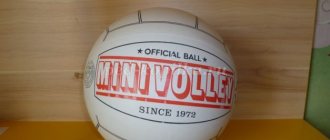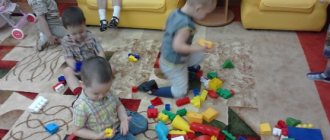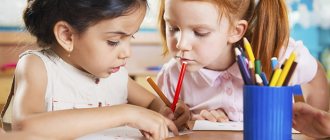It just seems that a 3-year-old baby requires less attention, because there is no need to change diapers or spoon-feed. In fact, now parents are faced with an equally important task - to raise a developed, harmonious personality who knows how to think.
Children aged 3-4 years begin the period of preschool development, they can do a lot, but most importantly, they strive to learn as much as possible.
In this article we will talk about what classes should be aimed at for children of this age.
What are the rules for organizing work with children?
It's no secret that classes for children from 3 years of age should be conducted in a playful way, but parents must understand that the actions of the child are only becoming purposeful. It is quite difficult for him to reach his goal, he is regularly distracted, and cannot maintain attention for a long time.
Children's interest can be developed if work is carried out using new and bright objects. However, you need to remember that this interest can either quickly arise or disappear.
The place for the activity should not distract the baby.
In order for exercises done at home to be as effective as possible, parents must know 3 simple rules:
- Toys and objects used in work should not be used in everyday life. This is necessary so that they do not lose interest in these subjects.
- While working, there should be no foreign objects on the table; everything unnecessary should be removed from children’s sight. This is an important condition in order to keep their attention in the right direction.
- The time spent working with children should not be exaggerated. The lesson should be short and uncomplicated. This is necessary so that the baby learns to finish what he has started.
Speech development tasks for three-year-old children
The most basic lessons in speech development are the usual reading of children's books to your baby. You can start a special ritual: evening reading with the whole family for 30-40 minutes. Reading should be accompanied by a discussion of events, to give the child an idea of why the heroes did this.
1. “Continue the tale . We take a story already familiar to the child about a kolobok or any other hero and offer to continue the story. During the story, the baby develops his imagination. Encourage your little one's interesting train of thought.
2. “Finish the phrase . Playing with an adult captivates the baby and enriches his vocabulary with new phrases. Offer tasks so that the child can think logically and add the correct expressions to his statements. For example: an adult says “It’s bright outside today...”, “When it rains, I’ll take it outside...”. And the baby ends the phrase with the words: sun, umbrella, rubber boots, etc.
3. “Describe the subject . The child needs to form and expand his vocabulary with new words and expressions. Use tasks to describe various objects. Show him the doll, take turns describing it: the doll’s name is Lera, the doll is wearing a beautiful red dress, she can close her eyes. The same actions can be carried out with any objects: an apple, a typewriter, a pyramid, a toothbrush, a kettle.
4. “Describe the walk . Go outside and every time ask your child about what he sees, what the weather is like now, how many birds you have fed, what color the road is. Add new elements each time. In autumn you can collect a collection of colorful leaves and pine cones. In summer, collect beautiful pebbles and describe them in 1-2 words.
In what form should lessons be taught?
Classes for children under 5 years of age should be held exclusively in the form of games. This is necessary due to the mental characteristics of the baby, because play is the leading activity for him. This age already allows the baby to come up with stories, play actions, and act as a director, that is, he himself comes up with the rules of the game.
The game form of educational activities is most suitable for children 3-4 years old
A gaming atmosphere can be created through bright, colorful and interesting materials. This is what you need to focus on when choosing books. Books must have clear and colorful pictures. Black and white illustrations can bore your little one, and too bright and bright colors will distract him.
The necessary emotional background can be created through the toys that come to the lesson: “Pinocchio came to us today and brought different figures.”
You can also encourage children to compete, for example, who can choose circles and squares from a variety of geometric shapes the fastest.
Naturally, you shouldn’t forget to praise the baby.
Tasks for developing attention in 3-year-old children
Concentration is an important skill that will be useful for children in kindergarten and school. Tasks for the development of attention are aimed at ensuring that the child is able to notice details and analyze.
• During a walk, you can ask your child to find and name objects that are similar in some way: “Find green objects.”
• Offer tasks to find identical objects from many similar ones. For example, socks are great for this exercise. Lay them out in a chaotic order, and the child must collect them in pairs, arranging them according to the picture.
• Attention game “Find the print”. The picture should show boots, shoes, boots, sandals. On the second part of the sheet there are their imprinted traces. The child needs to connect the shoes with the footprints with a line. • Place shapes cut out of colored cardboard in front of the baby: circle, triangle, square, rectangle. Help him make a truck, a house, a forest from the figures.
• Ask them to find differences in two pictures. The drawing should be large enough, and the details for searching should be bright. In the future it will be possible to complicate the drawings.
Choosing a time and place to work
In order for developmental activities for 4-year-old children to produce results, they must be regular. It is advisable to choose the same time and place at home. When choosing a time, it is necessary to take into account that the little one is alert, well-fed and active. You should experiment to see which time is most suitable.
Psychologists recommend in the morning or after a nap. You need to try to make work part of your daily routine.
Many parents wonder how long they should spend with their baby. The structure of the brain and the development of self-control in a 3-4 year old child allow him to withstand 15 minute lessons. However, with proper work and adaptation to the exercises, some children can easily withstand at least half an hour.
The first lessons should be no longer than 15 minutes
The first lessons usually do not exceed 10 minutes; you need to start small. As soon as the baby adapts, you can slowly increase the time, first up to 15 minutes. If he calmly endures it and remains cheerful and cheerful after that, then you can try increasing it to 20 minutes.
When choosing a place for daily work, first of all you need to pay attention to convenience. The workplace should be comfortable for both the baby and his mother, maybe it is a high chair with a table or a rug on which work takes place.
Making a plan
An important condition for effectiveness is planning. It is necessary so as not to get confused and forget something important. While working, you should stick to your plan. To organize interesting lessons, you need to plan the work in such a way that one type of activity is replaced by another.
The easiest way is to create a lesson plan and stick to it.
It is advisable to plan weekly, based on the results obtained in the previous week.
This is necessary in order to understand which type of exercises seem simple to the baby, and which ones seem difficult or boring. If something is difficult and inaccessible to him, then he needs to postpone this exercise for now and try to start it in a couple of weeks.
Mathematics
My daughter understands quantity, knows numbers. We count the apples in the store, the number of people in the family and the days in the week. I have prepared materials for comparing quantities and symbols, and I plan to continue the lessons in the future - I see that the child does it with pleasure.
Grandma also has numbers and round circles on magnets. Recently we came to visit them, I attached the numbers to the refrigerator: to number 1 - one round piece, to number 2 - two round pieces. She put the rest in a bowl, and Julia herself attached them to the numbers.
Using the clock puzzle, the child learned to count and understand that numbers can express quantity and order. In the living room there is a clock with hands, and opposite it there is an electronic clock with numbers. Already going to compare the values, but so far only 12 is unmistakably obtained
Using this set we study the numerical meaning of numbers. Next to each number is the number of items.
Sample lesson plan
Of course, each parent decides for himself how to conduct developmental activities at home with his children, but you can take the proposed plan below as a basis, choosing from it what his child needs at 3-4 years old.
Physical exercise
No development can be complete without physical activities with the child. This item can include anything, it is related to the child’s data, taking into account his and the parent’s wishes.
Home physical training is no less effective than in the gym
Everything should be carried out in a fun and light atmosphere; it would be good to turn on music, because in this way the baby will learn to move to it.
The main thing in this matter is not to overdo it, although this applies to all areas of development.
In addition, it is at home that you can determine the type of activity that your child likes and succeeds in. You can see his inclinations and send him to the appropriate section.
Development of fine motor skills of hands
Developmental exercises at this point are very important, because it is the development of fine motor skills that directly affects the development of the brain. It's no secret that the hands are directly connected to the head.
It is very good for children 3-4 years old to collect construction sets, mosaics, cubes, and here you can immediately repeat the colors and shapes.
In addition to motor skills, drawings using natural materials: pebbles, sand, shells develop the imagination very well.
Developmental toys for hand motor skills
Today, there are smart stores that will offer caring parents a rich assortment that will help them conduct educational lessons at home.
Creative lessons
Creativity develops the imagination well, these include: modeling, crafts, appliqué, drawing, including finger paints, various role-playing games, staging performances, puppet theater, shadow theater. These types can be listed endlessly, and 4-year-old children really love these types of activities.
Attention and memory training
It is very important to train memory and attention. Chess, checkers, and all kinds of dominoes are perfect for this. It’s good to train attention at home while playing; to do this, you can lay out 4-5 animals and change their places, while the child should turn away. Turning around, the baby must guess who swapped places with the teddy bear.
Board games for memory training
Reading
Children as young as 3 years old can begin to learn letters and sounds. This is a very important point. It’s good for children, when learning a letter to better remember it, to find it in a book, mold it from plasticine, or lay it out from pebbles. It would be nice to find it with your eyes closed in a plastic version. As you get acquainted, magnetic letters can be attached to the refrigerator so that they are in front of your eyes. Magnetic and plastic letters are also good for collecting syllables and words.
Important! During classes, parents should teach the child letters, while naming their sounds, that is, not “EL”, but “L”, not “BE”, but “B”, this will make it easier for the child to teach reading.
Check
Developmental exercises for 3-4 years should include learning to count, that is, the child can be introduced to ordinal counting up to 10. He can also lay out numbers from scrap materials and compose simple problems. At this age, mathematics is based on elementary logic, that is, with a little one you can look for a pair of an object, find an extra object.
Observations of the surrounding world must be active
Getting to know the world around you
At the age of 3-4 years, it is necessary to give the child basic concepts about our environment, we need to introduce him to animals, touching on the topic of domestic and wild, with the seasons, days of the week, precipitation, edible and inedible objects.
You should pay attention to such concepts as narrow - wide, high - low, large - small, long - short.
In addition, using the example of fairy tales, the topic of good and evil should be touched upon.
Child development is a very important process that needs to be carried out in a friendly and free manner; if the child is interested, then learning will happen faster and more effectively.
leave a comment
Sensory
It makes me happy when I hit a point of interest and the child gets carried away for a long time and tries something. So recently I noticed her craving for construction, and we purchased a magnetic construction set. I spent the whole day building it and couldn’t tear it away.
Developmental activities with sensory materials are very useful from the age of 3 years. They influence fine motor skills and indirectly prepare for writing and mathematics, as well as geometry and creativity. I made several sets with my own hands.
Noise cylinders. I made sound bottles from packages from Imunele - I simply poured beans, buckwheat and semolina into them. It is better to take cereals of different sizes.
Mysterious bag. You need to put objects of different shapes or textures into an opaque bag. The older the child, the less different they should feel to the touch. To complicate the game, you can add a second bag with the same contents. Ask them to find the same objects with different hands.
Paired color cards. A game-exercise on knowledge of colors and all shades. It starts with three basic colors and gradually increases in complexity to seven shades of each color: from the brightest to the palest. I want to get cards from the paint store so I can line up the colors.
We also arrange the chocolate egg fixies according to height. Or while walking in the forest we look for thick and thin trunks.
We have 2 rooms in our apartment: a kitchen-living room and a bedroom. In the living room there is a separate children's bookcase and a shelf for books. I change the materials from time to time, so this is once a creativity zone, once a music and sensory zone, but a set for caring for plants and a jug of water are always in their place. Nearby there is a workplace consisting of a table with a chair and a shelf for books.


